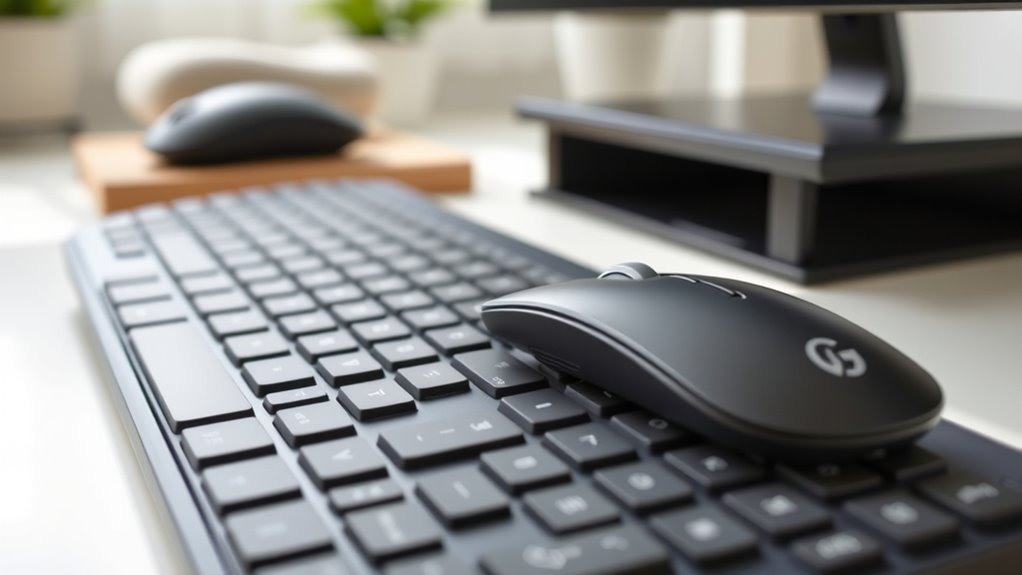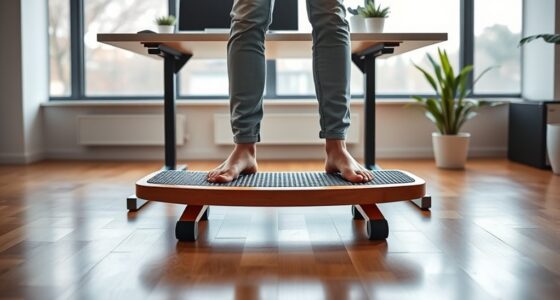To stop wrist pain, invest in ergonomic keyboard and mouse options that support natural hand positioning. Choose a split or curved keyboard, and use a mouse with adjustable sensitivity and contours to reduce strain. Keep your devices at elbow height, with wrists straight and aligned with forearms. Incorporate wrist supports or pads for additional comfort. Proper positioning combined with ergonomic accessories can make a big difference—exploring more tips can help you maintain healthier wrists.
Key Takeaways
- Use ergonomic keyboards with split or curved designs to promote natural wrist positioning.
- Incorporate wrist supports like gel pads or adjustable stands to reduce strain during prolonged use.
- Keep your keyboard and mouse at a height that allows elbows to be at approximately 90°, maintaining wrist alignment.
- Choose ergonomic mice with proper contours and adjustable sensitivity to minimize wrist movement.
- Regularly adjust your workspace setup to ensure wrists remain straight and supported, preventing long-term injuries.

When it comes to enhancing your workspace, choosing the right keyboard and mouse can make a significant difference. If you spend hours typing or scrolling, your wrists can become strained, leading to discomfort or even long-term injuries like carpal tunnel syndrome. To prevent this, investing in ergonomic accessories is essential. These accessories are designed specifically to promote better wrist posture, reduce strain, and keep you comfortable throughout your workday. One of the most effective ways to achieve this is by selecting the right wrist support options.
Choosing the right ergonomic wrist support can significantly reduce strain and prevent injury during long hours at your workspace.
Wrist supports are available in various forms, from gel-filled pads to adjustable stands. When you choose a wrist support, look for features that allow your wrists to rest in a neutral position—neither flexed nor extended. This helps maintain proper alignment and minimizes pressure on the median nerve and tendons. A well-designed wrist support acts as a cushion, absorbing impact and preventing your wrists from resting directly on a hard surface. This simple addition can dramatically reduce fatigue and discomfort, especially during long typing sessions.
In addition to wrist supports, ergonomic accessories such as split or curved keyboards can also help alleviate wrist pain. These designs encourage a more natural hand position, decreasing the need to twist or bend your wrists awkwardly. Pairing these keyboards with an ergonomic mouse that fits comfortably in your hand further enhances your setup. Look for mice with adjustable sensitivity and ergonomic contours tailored to your grip style. When your mouse fits well, it reduces the effort needed for each movement, decreasing strain on your wrist and forearm muscles.
Positioning is equally important. Keep your keyboard and mouse at a height where your elbows are bent at about a 90-degree angle, and your wrists are in a straight line with your forearms. Using wrist support options in tandem with proper placement ensures your wrists are protected from unnecessary stress. Some ergonomic accessories come with adjustable stands or platforms that elevate your devices, helping you find the ideal height and angle. Additionally, choosing ergonomic accessories designed with the latest research can further optimize comfort and prevent injury.
Frequently Asked Questions
How Can I Tell if My Wrist Pain Is Serious?
If you’re wondering whether your wrist pain is serious, pay attention to its duration and intensity. If the pain persists despite wrist stretches and ergonomic adjustments, or if you notice numbness, tingling, or weakness, see a healthcare professional. Serious issues might involve nerve or joint damage. Don’t ignore persistent pain—consult a doctor to rule out conditions that require treatment beyond simple remedies.
Are There Specific Exercises to Prevent Wrist Strain?
Many believe that specific exercises can prevent wrist strain, and there’s truth to it. Regular wrist stretching helps maintain flexibility, while hand strengthening exercises build muscle support, reducing stress on your joints. Incorporate gentle wrist circles, finger stretches, and grip exercises into your routine. Doing these daily can improve wrist health, prevent pain, and keep you comfortable during long hours at your computer.
What Signs Indicate My Workstation Setup Is Causing Pain?
If you’re experiencing pain, your workstation setup might be the culprit. Look for signs like persistent wrist discomfort, numbness, or tingling. Make certain your ergonomic chair adjustments are correct, supporting your lower back and maintaining proper posture. Also, check your monitor height alignment so your eyes are level, preventing strain. These adjustments help reduce strain and prevent pain, making your workspace more comfortable and ergonomic.
Can Ergonomic Accessories Completely Eliminate Wrist Discomfort?
While ergonomic accessories can considerably reduce wrist pain, they might not completely eliminate it. You’ll find that these tools, like wrist rests or adjustable keyboards, support proper alignment. However, if underlying issues like poor posture or repetitive strain persist, discomfort may linger. Think of ergonomic accessories as essential allies—they improve comfort but aren’t a total cure. Combining them with good habits offers your best chance at lasting relief from wrist pain.
How Often Should I Take Breaks to Prevent Wrist Injuries?
To prevent wrist injuries, you should take a rest period every 30 to 60 minutes, depending on your activity intensity. Break frequency is key; brief breaks help reduce strain and improve circulation. During these pauses, stretch your wrists and hands to relieve tension. Remember, consistent short breaks are more effective than infrequent long ones, helping you maintain comfort and prevent discomfort during long hours at your keyboard or mouse.
Conclusion
By adopting these ergonomic tips, you can protect your wrists like a skilled artist safeguarding their canvas. Imagine your hands gliding smoothly over your keyboard and mouse, free from pain and strain, much like a gentle breeze flowing through a calm meadow. With simple adjustments, you’ll keep your wrists healthy and your productivity soaring, turning every work session into a seamless, pain-free dance. Take control today, and let comfort be your guiding brushstroke.









